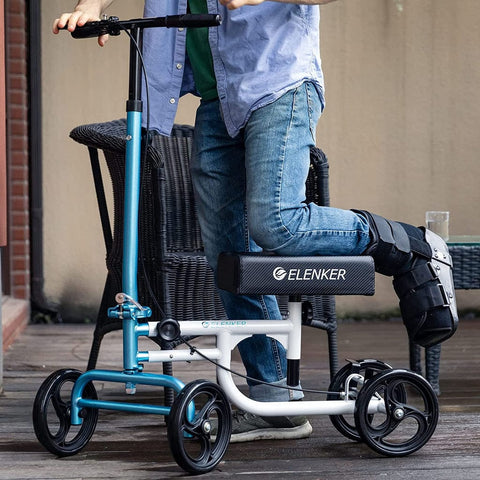SAFELY OPERATE A KNEE WALKER
Feb 18, 2022
Safety First! How to Safely operate a Knee Walker
Before operating a knee walker, read through the Owner’s Manual to ensure that the unit is assembled as per the manufacturer’s provided instructions. This is also a good place to get acquainted with the various parts and controls, as well as precautions.
Most knee walkers, including all of our Elenker® products, feature an adjustable knee pad and handlebar height to ensure you can dial in the most comfortable operation with proper posture. Please see the image below which demonstrates proper posture. You will notice that the handlebar is set at waist height so the arms and hands are in a comfortable position. You can also see that while standing naturally the hips are even, with the uninjured foot flat on the ground, and the injured leg is supported at a 90 degree angle. Keep your head up, so you can safely navigate around obstacles.

Before mounting the knee walker, ensure that the hand brake is fully engaged so that the knee walker cannot roll away. Upon placing the injured leg on the knee pad and getting balanced, you can release the hand brake and begin moving. To move the knee walker, simply push with the good foot, forwards or backwards, much like a child’s scooter. Allow the knee walker to glide, and as it slows down, push again.
SAFETY TIPS:
Knee Walkers are not high speed vehicles. They should be used to carefully move about at controlled speeds. When turning a knee walker, one should have the brake applied and be moving at a slow, safe, controlled speed as it's possible to tip the knee scooter if you are making a turn with too much speed. Also going downhill, one must use extra caution in maintaining a safe speed. In addition to the hand brake, you can use your good leg to slow the knee walker.
To maintain safe balance, always keep your knee on the pad and your weight over the center of the knee scooter. Limit reaching or stretching out away from your knee walker as this can throw off your balance.
Use caution – balance and operate at your own risk. With routine use nuts and bolts can and likely will become loose. Periodically check nuts and bolts after use and re-tighten as appropriate.





